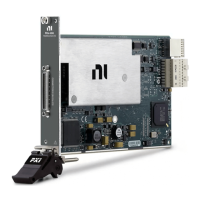© National Instruments | 8-3
X Series User Manual
• AI Start Trigger (ai/StartTrigger)
• AI Pause Trigger (ai/PauseTrigger)
• AO Sample Clock
*
(ao/SampleClock)
• AO Start Trigger (ao/StartTrigger)
• AO Pause Trigger (ao/PauseTrigger)
• DI Sample Clock (di/SampleClock)
• DI Start Trigger (di/StartTrigger)
• DI Reference Trigger (di/ReferenceTrigger)
• DI Pause Trigger (di/PauseTrigger)
• DO Sample Clock
*
(do/SampleClock)
• DO Start Trigger (do/StartTrigger)
• DO Pause Trigger (do/PauseTrigger)
• Counter n Source
• Counter n Gate
• Counter n Internal Output
• Counter n Sample Clock
• Counter n Counter n HW Arm
• Frequency Output
• PXI_STAR
• RTSI <0..7>
• Analog Comparison Event
• Change Detection Event
• Watchdog timer expired pulse
Note Signals with an
*
are inverted before being driven to a terminal; that is, these
signals are active low.
Note (NI PXIe-6386/6396 Devices) PXIe-6386 and PXIe-6396 devices differ in
several ways from other SMIO devices. For more information about sample clock
rates related to these devices, go to ni.com/info and enter the Info Code
smio14ms.
Using PFI Terminals as Static Digital I/Os
Each PFI can be individually configured as a static digital input or a static digital output. When
a terminal is used as a static digital input or output, it is called P1.x or P2.x. On the I/O connector,
each terminal is labeled PFI x/P1.x or PFI x/P2.x.
In addition, X Series devices have up to 32 lines of bidirectional DIO signals.

